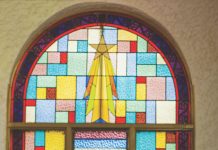As I walked out to the garden shed, I noticed my bedding of Easter lilies had broken ground and were preparing to bloom, right on time, right near Easter. I wondered why the early church had attached the name of a pagan fertility goddess, Ishtar, to the holiest day of Christianity. Well, whatever the reason, I do like that these flowering plants burst out of the ground and bloom just in time for Passover.
As I walked out to the garden shed, I noticed my bedding of Easter lilies had broken ground and were preparing to bloom, right on time, right near Easter. I wondered why the early church had attached the name of a pagan fertility goddess, Ishtar, to the holiest day of Christianity. Well, whatever the reason, I do like that these flowering plants burst out of the ground and bloom just in time for Passover.
Jesus rising from the grave, springing back to life is paramount to a Christian’s faith. It is our great hope and God’s promise to us all that we too will be reborn. By studying prophecy, recorded hundreds of years before Jesus Christ was born, you will begin to see how the Messiah fulfilled Passover by becoming “the Lamb of God that takes away the sin of the world.”
Five hundred and some odd years before Jesus of Nazareth rode into Jerusalem on a barrowed donkey, the prophet Zechariah wrote in Zechariah chapter nine “Rejoice greatly, O daughter of Zion! Shout, O daughter of Jerusalem! Behold your King is coming to you; He is just and having salvation, lowly and riding on a donkey, a colt, the foal of a donkey.”
In the book of Daniel chapter nine the angel Gabriel gives Daniel a prophecy about when the Messiah would appear. “And after sixty-two weeks Messiah shall be cut off, but not for Himself.”
What is utterly striking is that Jesus rode into Jerusalem on that first Palm Sunday on the exact day predicted by Gabriel.
If you combine the sixty-two weeks (of years), from the book of Daniel chapter nine, with the command to rebuild Jerusalem by King Artaxerxes, the date given in Nehemiah chapter two, it predicted the exact day Jesus rode into Jerusalem. We now call that day Palm Sunday, which would have coincided with the 10th day of Abib, four days later on the 14th day of Abib, Jesus was crucified.
Upon further study, the gospel accounts of the Messiah’s triumphant entry into Jerusalem described how a large crowd had showed up to lay palm branches and cloaks on the road before the donkey. As they lay their branches on the road, not only were they making straight the way for the coming King, they were also shouting “Hosanna” or “save now!” which was prophesied in Psalm one hundred-eighteen.
It is tragic how many Christians do not understand these truths of scripture. What is more tragic is the fact the people of Jesus’ day did not recognize the full extent of what Jesus was coming to do. Even the religious leaders did not recognize that the Lord was fulfilling the feast of Passover which devout Jews had been celebrating every year since their exodus from Egypt.
As Jesus rode into the Temple, He was declaring and presenting Himself for inspection as the Lamb of God who would take away the sin of the world. Jesus was without spot or blemish. He arrived on the 10th day of Abib and would be slain on the 14th day as was outlined in the book of Exodus chapter twelve. Unfortunately, the religious Jewish leaders were blind to this dispensation of God’s plan to redeem mankind through the Messiah’s death on a Roman cross.
The last four days of Jesus’ life culminates on Wednesday at sundown on the Jewish feast of Passover. It is recorded in the gospel of Luke chapter twenty-two that Jesus said “With fervent desire I have desired to eat this Passover with you before I suffer; for I say to you, I will no longer eat of it until it is fulfilled in the kingdom of God.”
Then after the cup was passed and the bread broken, Jesus washed the feet of all the disciples. He did this to quench an on-going dispute, among His disciples, as to who was the greatest.
It was a dark night indeed as the Son of God was arrested, beaten, falsely accused and illegally tried. The Messiah, Son of God would be nailed to a cross and left to die a slow, agonizing death. As horrible as it sounds, the crucifixion of Jesus was actually God’s greatest triumph that redeemed mankind once and for all. However, the story does not end at His death, for three days later the lifeless body of Jesus would return with life!
So there I am, looking at how striking my Easter lilies are as they push their way up and out of the ground. They were so beautifully adorned in their new spring clothes and looked as if they were stretching up towards the sun, thanking God for their new life. As several thoughts dawned on me, I offered up a smile in thankfulness for my new life in Jesus Christ. He is risen!













